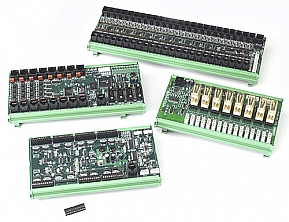| PC-Based Machine Control | |
|---|---|
| Today, the PC is the reigning king of machine control applications and Ethernet I/O is the king's "right-hand man." It wasn't always this way, though; at one time PLCs (programmable logic controllers) were the preferred controller for machine control applications. The story of PC-based machine control, and how the PC became the world's most widely used machine controller, reads something like a modern-day techno fairy tale. |

|
The King and His Right-Hand ManOnce upon a time, PLCs ruled the world of machine control applications. These expensive, exalted controllers spent their lives resting on lavish rack-mount thrones in air-conditioned comfort. Priceless interface boards were bestowed upon them to enable them to rule their realms. Specially trained, highly paid servants would come to service them whenever they suffered from even the slightest malady. Once installed, these dictators quickly became entrenched by propagating the seeds of their proprietary ways throughout their empires. As time went on, PCs grew up and became as capable as the ruling PLCs. The spry, young PCs demonstrated a degree of versatility that was unheard of in any PLC. The PCs cost much less, had industry standard backplanes and were compatible with low-cost interface boards from multiple vendors. Soon it became apparent that PCs were well-suited for royal endeavors such as machine control. New machine control kingdoms were continually emerging across the land, and of course, each of these had a need for a controller. In a process as ancient as the PLCs themselves, the strongest controller would rise up to become king of each new realm. Now it turns out that due to their many advantages over PLCs, modern PCs began to appear as the chosen rulers of newly developed kingdoms. This was the beginning of a new era of PC-based machine control, in which PCs became the predominant ruling class for machine control applications. Still, even the most powerful PCs could not uproot the firmly entrenched PLCs who ruled over existing kingdoms. These despotic PLCs employed numerous methods to fend off potential challengers. They hoarded all of their exquisite, built-in I/O interfaces, permitting only hand-picked hardware to work in the palace. They spoke in strange tongues and decreed that all outsiders must also speak in those tongues. They structured their kingdoms in uncommon ways so as to interject significant financial and technical barriers in the paths of contenders for the throne. The PLCs were determined to forever maintain their iron grips on absolute power. Gradually, and without much notice at first, Ethernet-based I/O systems began to take up residence in machine control kingdoms. The earliest of these immigrants had little impact on the kingdoms because they spoke unusual tongues and had limited skills. Over time, however, these immigrants spawned a new generation that grew up speaking universal tongues such as ARP, ICMP and TCP/IP. The new generation also acquired useful skills such as digital I/O, analog I/O, solid state relay control and incremental encoder interface abilities. Soon it was common knowledge throughout the machine control world that a PC with an Ethernet interface could not only rule the local kingdom, but also the distant lands that were beyond the reach of the built-in I/O interfaces employed by PLCs. Ironically, the very same proprietary mechanisms used to defend against aggressors now worked against the PLCs. It was just a matter of time before even the most ingrained PLCs were being replaced with PCs and Ethernet I/O systems. In the end, the despotic PLCs lost their hold on absolute power over machine control applications. The PC-based machine control kingdoms lived happily ever after, ruled by their benevolent PC kings and Ethernet I/O systems. |
|

